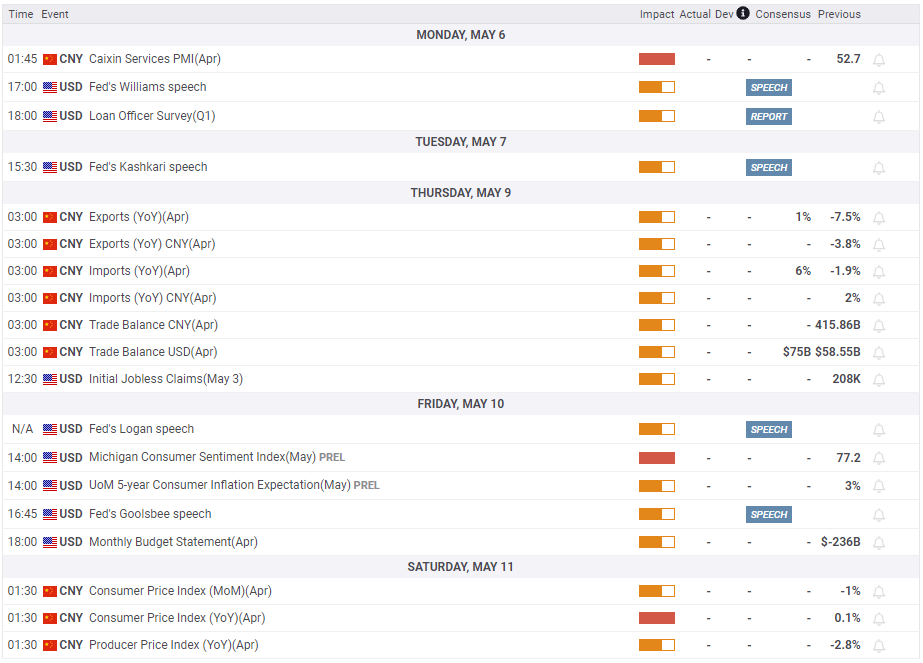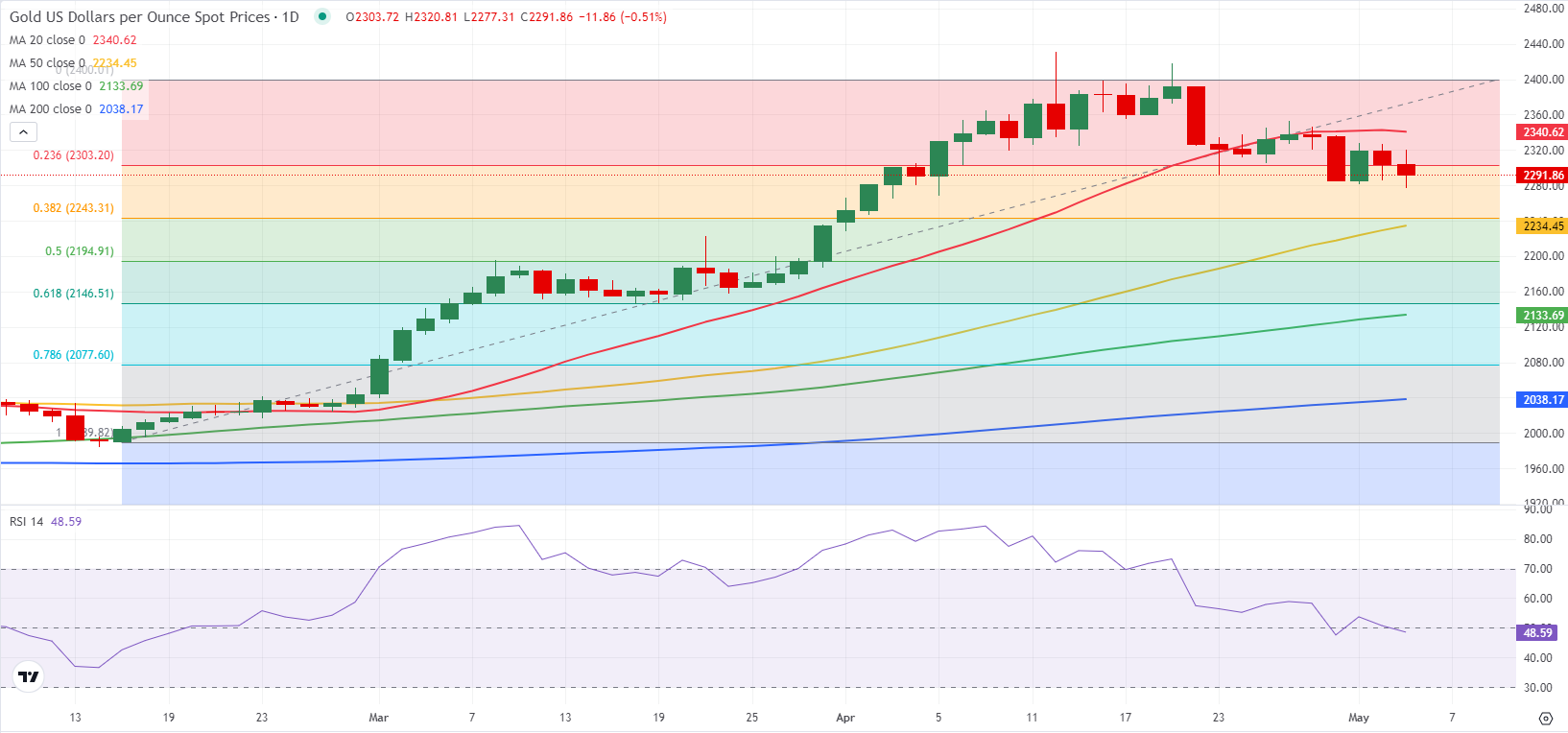- Gold struggled to gather recovery momentum following the bearish action seen in the first half of the week.
- The near-term technical outlook points to a bearish tilt.
- In the absence of high-impact data releases, Fedspeak could drive XAU/USD’s action next week.
Gold (XAU/USD) price fell more than 2% for the second consecutive week, erased a small portion of its losses but finally came under renewed bearish pressure. The near-term technical outlook points to a loss of bullish momentum as the market focus shifts to Fedspeak.
Gold ended the choppy week in negative territory
Gold started the new week in a calm manner and closed virtually unchanged on Monday. However, XAU/USD turned south and dropped to its weakest level in over three weeks below $2,290 on Tuesday, losing more than 2% on a daily basis. The decline came after data from the US showed that the Employment Cost Index rose 1.2% in the first quarter following the 0.9% increase recorded in the fourth quarter of 2023. This reading surpassed the market expectation of 1% and helped US Treasury bond yields push higher, forcing Gold to push lower. Meanwhile, the USD continued to gather strength after The Wall Street Journal reporter Nick Timiraos reported that the Federal Reserve (Fed) will emphasize that they are prepared to hold rates steady for longer than previously anticipated, due to strong inflation readings seen in the first quarter of the year.
On Wednesday, the Fed announced that it left the policy rate unchanged at 5.25%-5.5% as forecast. In its policy statement, the Fed also said that they will dial back the pace of balance sheet reduction by lowering the Treasury redemption cap to $25 billion per month from $60 billion starting June 1.
When asked about the possibility of policy tightening in the face of persistent inflation in the post-meeting press conference, Fed Chairman Jerome Powell said that it was unlikely that the next interest rate move would be a hike. Powell refrained from providing any clues regarding the timing of the policy pivot but acknowledged that it was likely that it will take longer than previously anticipated to gain the greater confidence needed in inflation moving toward the 2% target to lower the policy rate. The benchmark 10-year US Treasury bond yield lost more than 1% late Wednesday and the USD weakened against its rivals as the Fed event turned out to be not as hawkish as feared. As a result, XAU/USD recovered back above $2,300. Meanwhile, the Bank of Japan (BoJ) seemingly intervened in the foreign exchange market for the second time this week in the late American session on Wednesday, putting additional weight on the USD’s shoulders.
Following the Fed-inspired decline, the USD managed to stage a rebound on Thursday, capping XAU/USD’s upside, after the US Bureau of Labor Statistics (BLS) reported that Unit Labor Costs rose 4.7% in the first quarter. With risk flows starting to dominate the action in financial markets later in the American session, the USD lost its strength and allowed XAU/USD to end the day slightly above $2,300.
The BLS announced on Friday that Nonfarm Payrolls rose 175,000 in April. This reading fell short of the market expectation for an increase of 243,000. Other details of the report showed that the Unemployment Rate edged higher to 3.9%, while the Labor Force Participation Rate remained unchanged at 62.7%. Additionally, Average Hourly Earnings rose 0.2% on a monthly basis, compared to analysts’ estimate of 0.3%. Despite the soft labor market data, Gold failed to attract investors as markets remained risk-positive heading into the weekend.
Gold investors’ focus shifts to Fedspeak
The US economic docket will not feature any high-tier data releases that could impact Gold’s valuation in a significant way next week. On Thursday, Trade Balance data from China will be watched closely by market participants. In case China’s trade surplus widens more than expected in April, the initial market reaction could help XAU/USD push higher, with investors assessing that as a positive development for Gold’s demand outlook.
Market participants will also keep a close eye on comments from Fed officials next week. According to the CME FedWatch Tool, the probability of a Fed policy pivot in September stays slightly above 50% after the Fed event. In case Fed policymakers leave the door open to a rate cut in September, the market positioning suggests that the USD could come under selling pressure. On the other hand, the USD is likely to hold its ground and make it difficult for XAU/USD to gain traction if Fed officials voice favoritism of a rate reduction closer to the end of the year. Nevertheless, policymakers will have several more inflation and employment data to assess until September and they could avoid offering any clear signals regarding the timing of the policy pivot.
Gold technical outlook
The Relative Strength Index (RSI) indicator on the daily chart declined below 50, pointing to a bearish tilt in the short term. Additionally, the last five daily XAU/USD candles closed below the 20-day Simple Moving Average (SMA).
The Fibonacci 23.6% retracement of the February-April uptrend forms a pivot level at $2,300. In case Gold continues to use that level as resistance, technical sellers could remain interested. In this scenario, $2,280 (static level) could be seen as interim support before $2,245 (Fibonacci 38.2% retracement) and $2,235 (50-day SMA).
On the upside, resistance levels could be seen at $2,340 (20-day SMA), $2,360 (static level) and $2,400 (end-point of the uptrend) once XAU/USD stabilizes above $2,300.
Gold FAQs
Gold has played a key role in human’s history as it has been widely used as a store of value and medium of exchange. Currently, apart from its shine and usage for jewelry, the precious metal is widely seen as a safe-haven asset, meaning that it is considered a good investment during turbulent times. Gold is also widely seen as a hedge against inflation and against depreciating currencies as it doesn’t rely on any specific issuer or government.
Central banks are the biggest Gold holders. In their aim to support their currencies in turbulent times, central banks tend to diversify their reserves and buy Gold to improve the perceived strength of the economy and the currency. High Gold reserves can be a source of trust for a country’s solvency. Central banks added 1,136 tonnes of Gold worth around $70 billion to their reserves in 2022, according to data from the World Gold Council. This is the highest yearly purchase since records began. Central banks from emerging economies such as China, India and Turkey are quickly increasing their Gold reserves.
Gold has an inverse correlation with the US Dollar and US Treasuries, which are both major reserve and safe-haven assets. When the Dollar depreciates, Gold tends to rise, enabling investors and central banks to diversify their assets in turbulent times. Gold is also inversely correlated with risk assets. A rally in the stock market tends to weaken Gold price, while sell-offs in riskier markets tend to favor the precious metal.
The price can move due to a wide range of factors. Geopolitical instability or fears of a deep recession can quickly make Gold price escalate due to its safe-haven status. As a yield-less asset, Gold tends to rise with lower interest rates, while higher cost of money usually weighs down on the yellow metal. Still, most moves depend on how the US Dollar (USD) behaves as the asset is priced in dollars (XAU/USD). A strong Dollar tends to keep the price of Gold controlled, whereas a weaker Dollar is likely to push Gold prices up.
Information on these pages contains forward-looking statements that involve risks and uncertainties. Markets and instruments profiled on this page are for informational purposes only and should not in any way come across as a recommendation to buy or sell in these assets. You should do your own thorough research before making any investment decisions. FXStreet does not in any way guarantee that this information is free from mistakes, errors, or material misstatements. It also does not guarantee that this information is of a timely nature. Investing in Open Markets involves a great deal of risk, including the loss of all or a portion of your investment, as well as emotional distress. All risks, losses and costs associated with investing, including total loss of principal, are your responsibility. The views and opinions expressed in this article are those of the authors and do not necessarily reflect the official policy or position of FXStreet nor its advertisers. The author will not be held responsible for information that is found at the end of links posted on this page.
If not otherwise explicitly mentioned in the body of the article, at the time of writing, the author has no position in any stock mentioned in this article and no business relationship with any company mentioned. The author has not received compensation for writing this article, other than from FXStreet.
FXStreet and the author do not provide personalized recommendations. The author makes no representations as to the accuracy, completeness, or suitability of this information. FXStreet and the author will not be liable for any errors, omissions or any losses, injuries or damages arising from this information and its display or use. Errors and omissions excepted.
The author and FXStreet are not registered investment advisors and nothing in this article is intended to be investment advice.
Recommended Content
Editors’ Picks

Gold retreats from record highs at $3,220 ahead of US data
Gold price is retreating from fresh all-time highs of $3,220 in early Europe on Friday. The US Dollar downward spiral and escalating trade war between the United States and China continue to underpin the safe-haven appeal of Gold price. US PPI inflation data and tariff updates remain on tap.

EUR/USD consolidates weekly gains near 1.1250 ahead of Lagarde's speech
EUR/USD is consolidating the uptick to three-year highs of 1.1385 in Friday's European session. The pait stays supported amid easing US-EU trade tensions and broad US Dollar weakness. Tarff talks will be closely eyed alongside Lagarde's speech and US data.

GBP/USD holds gains near 1.3000 after UK data
GBP/USD is paring back gains to near 1.3000 in Friday’s early European session. The pair stays firm as the US Dollar loses ground amid lingering concerns over US economic growth and US-China trade war. Upbeat UK economic data fail to impress the Pound Sterling.

Bitcoin, Ethereum and Ripple show weakness while XRP stabilizes
Bitcoin and Ethereum prices are hovering around $80,000 and $1,500 on Friday after facing rejection from their respective key levels, indicating signs of weakness. Meanwhile, Ripple broke and found support around its critical level; maintenance suggests a recovery on the cards.

Trump’s tariff pause sparks rally – What comes next?
Markets staged a dramatic reversal Wednesday, led by a 12% surge in the Nasdaq and strong gains across major indices, following President Trump’s unexpected decision to pause tariff escalation for non-retaliating trade partners.

The Best brokers to trade EUR/USD
SPONSORED Discover the top brokers for trading EUR/USD in 2025. Our list features brokers with competitive spreads, fast execution, and powerful platforms. Whether you're a beginner or an expert, find the right partner to navigate the dynamic Forex market.

